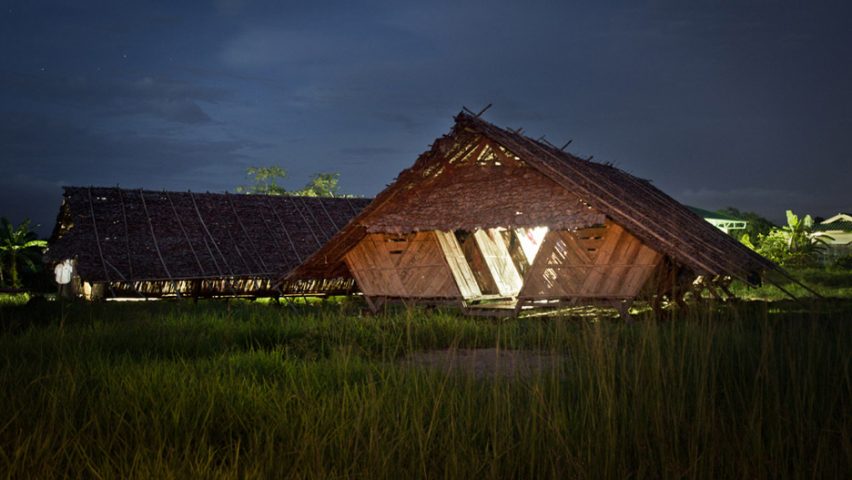The refugee crisis is one of five topics we will explore as part of Good Design for a Bad World at Dutch Design Week. Here's a look at eight responses from designers, which suggest ways that displaced people can be better integrated into communities.
The refugee crisis joins four other global issues – climate change, pollution, terrorism and politics – that will be discussed during the Good Design for a Bad World talks programme, which Dezeen is hosting in Eindhoven on 21 and 22 October 2017.
Moderated by Dezeen founder and Dutch Design Week international ambassador Marcus Fairs, the speaker lineup for the refugee talk includes Kilian Kleinschmidt, former refugee camp manager and founder of humanitarian consultancy Switxboard; and Rene Boer, a critic and master in urban studies with links to social movements in Europe and the Middle East.
It takes place at the People's Pavilion at KetelHuisplein 1, in the Strijp-S district of Eindhoven, at 2:30pm on Saturday 21 October.
Ahead of the panel discussion, we've rounded up eight projects that aim to make a positive difference in the lives of refugees, including a conceptual "living room" designed to bring new arrivals and locals together, and a mobile embassy for stateless people.
Mae Tao Dormitories by Agora Architects
With room inside for up to 25 people, these accommodation buildings were designed by Agora Architects for those arriving in Thailand from Burma, the south-east Asian country that has been embroiled in civil war since the 1940s.
Unlike the tents and other fast assembly structures used to house refugees, these structures fit in with the local architecture. They are built from recycled timber, which accounts for around 70 per cent of the overall cost, and could easily be dismantled and reassembled in a new location if necessary.
Find out more about Mae Tao Dormitories ›
De Voorkamer by Pim van der Mijl
Pim van der Mijl's De Voorkamer project – meaning "the living room" – proposes a communal meeting space to help break down barriers between refugees and local communities in Holland.
Asylum seekers would use their own skills and abilities to contribute self-made objects to the space, such as pieces of furniture or textiles, gradually turning it into something resembling a more welcoming living room.
Find out more about De Voorkamer ›
IKEA's social sustainability drive
In the year that saw IKEA win Design of the Year for its flat-pack refugee shelter, the Swedish furniture giant decided to continue its humanitarian efforts – announcing that it aims to take 200,000 people out of poverty in a massive social sustainability drive.
To do this, the company plans is employing refugees at production centres in Jordan. Its long-term plan is to create employment for a mixture of Syrian refugees and Jordanians in the production of woven products including rugs, cushions and bedspreads.
Find out more about IKEA's social sustainability drive ›
Dutch designers Didi Aaslund and Floor Nagler worked with refugees on the Greek island of Lesbos to create a series of rucksacks from discarded boats and life vests.
Although they encountered some hiccoughs with their Kickstarter funding campaign, their aim is to turn the project into a business that gives employment to displaced people.
Find out more about BAG2WORK ›
Wearable Habitation coat by RCA art students
A group of students from London's Royal College of Art designed this prototype coat for refugees that transforms into a tent or a sleeping bag.
When worn as a coat, the insulated Wearable Habitation resembles a baggy parka with a large hood, and features pockets on the inside for storing passports and personal documents. Black zips allow the coat to be completely opened out and transformed into a sleeping bag. Lightweight kite-rods can then be fed through specific seams to form a tent.
Find out more about Wearable Habitation coat ›
In Limbo Embassy by Manon van Hoeckel
Van Hoeckel's graduation project was designed to make people look differently at the refugee situation, rather than solve it.
It proposed mobile embassies for stateless people, where asylum seekers themselves worked as ambassadors. Passers-by were invited to come in to share their stories, to find out how refugees and local communities can help one another.
Find out more about In Limbo Embassy ›
Airbnb has ramped up its humanitarian efforts in light of various crises happening across the world. In June, the company harnessed its vast network of short-term home rentals to create a new platform providing housing for refugees named Open Homes, which is the key project to come out of its new in-house humanitarian team led by designer Cameron Sinclair.
The Open Homes platform allows users who are already registered on the site as hosts to easily offer up their rooms to refugees and displaced people for free. Qualifying relief organisations and non-profits are able to take up the offers by booking rooms on a short-term basis for refugees and other people in need. Airbnb hopes it will provide temporary housing for 100,000 people within five years.
Find out more about Open Homes ›
Rehome by Lahti University students
Ten students from Finland's Lahti University of Applied Sciences designed this collection of essential furniture items for those who have had to suddenly leave their homes without belongings.
Students came up with a list of things that would cater to "the most urgent human needs", which they identified as sleeping arrangements, privacy, and social interaction. Low-cost materials were used, such as plywood and cardboard. To make the furniture as efficient to assemble as possible, the designers opted for a slotting method – meaning each piece can also be taken down quickly and easily.

